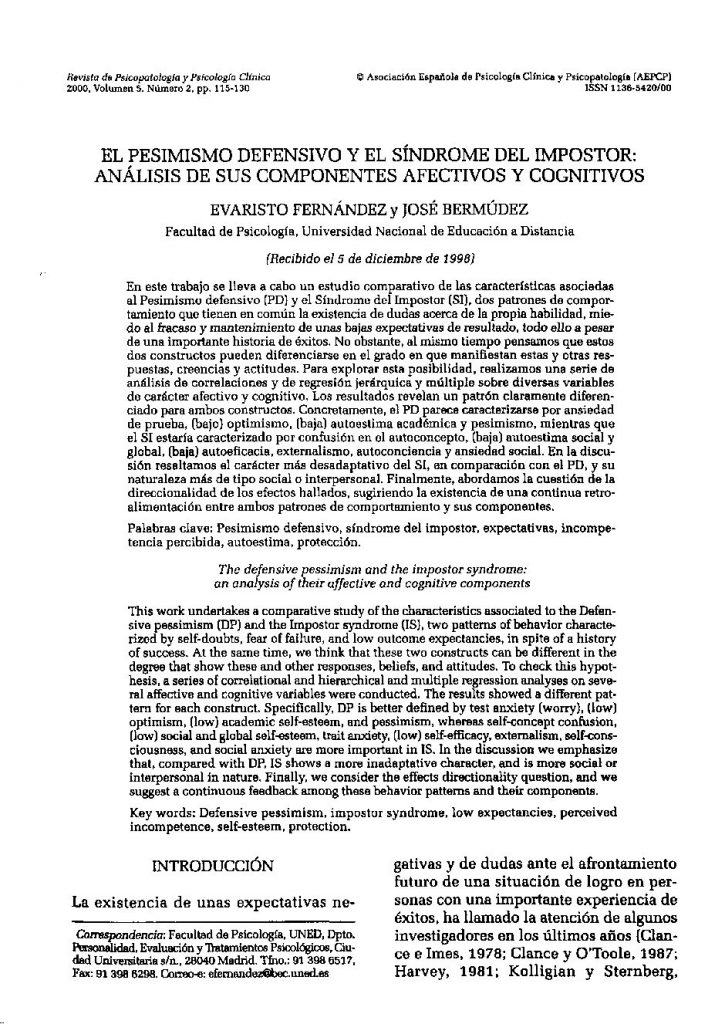El pesimismo defensivo y el síndrome del impostor: análisis de sus componentes afectivos y cognitivos.

- Comisión Nacional de Psicología Clínica Conclusiones del I Encuentro Nacional de Tutores de Formación Especializada en Psiquiatría y Psicología Clínica.
- Estímulos verbales asociados a hipocondría.
- El pesimismo defensivo y el síndrome del impostor: análisis de sus componentes afectivos y cognitivos.
- Evaluación de un programa de tratamiento psicológico para dejar de fumar: el efecto del feedback de CO.
- ¿Cómo somos, en qué ocupamos nuestro tiempo y cuán felices nos sentimos?.
This work undertakes a comparative study of the characteristics associated to the Defensive pessimism (DP) and the Impostor syndrome (IS), two patterns of behavior characterized by selfdoubts, fear of failure, and low outcome expectancies, in spite of a history of success. At the same time, we think that these two constructs can be different in the degree that show these and other responses, beliefs, and attitudes. To check this hypothesis, a series of correlational and hierarchical and multiple regression analyses on several affective and cognitive variables were conducted. The results showed a different pattern for each construct. Specifically, DP is better defined by test anxiety (worry), (low) optimism, (low) academic self-esteem, and pessimism, whereas self-concept confusion, (low) social and global self-esteem, trait anxiety, (low) selfefficacy, externalism, self-consciousness, and social anxiety are more important in IS. In the discussion we emphasize that, compared with DP, IS shows a more inadaptative character, and is more social or interpersonal in nature. Finally, we consider the effects directionality question, and we suggest a continuous feedback among these behavior patterns and their components.
En este trabajo se lleva a cabo un estudio comparativo de las características asociadas al Pesimismo defensivo (PD) y el Síndrome del Impostor (SI), dos patrones de comportamiento que tienen en común la existencia de dudas acerca de la propia habilidad, miedo al fracaso y mantenimiento de unas bajas expectativas de resultado, todo ello a pasar de una importante historia de éxitos. No obstante, al mismo tiempo pensamos que estos dos constructos pueden diferenciarse en el grado en que manifiestan estas y otras respuestas, creencias y actitudes. Para explorar esta posibilidad, realizamos una serie de análisis de correlaciones y de regresión jerárquica y múltiple sobre diversas variables de carácter afectivo y cognitivo. Los resultados revelan un patrón claramente diferenciado para ambos constructos. Concretamente, el PD parece caracterizarse por ansiedad de prueba, (bajo) optimismo, (baja) autoestima académica y pesimismo, mientras que el SI estaría caracterizado por confusión en el autoconcepto, (baja) autoestima social y global, (baja) autoeficacia, externalismo, autoconciencia y ansiedad social. En la discusión resaltamos el carácter más desadaptativo del SI, en comparación con el PD, y su naturaleza más de tipo social o interpersonal. Finalmente, abordamos la cuestión de la direccionalidad de los efectos hallados, sugiriendo la existencia de una continua retroalimentación entre ambos patrones de comportamiento y sus componentes.



